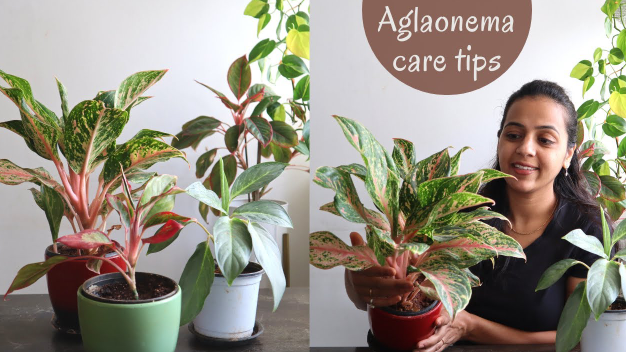Introduction
Aglaonema, commonly known as the Chinese evergreen, is a popular indoor plant admired for its lush green foliage and low-maintenance care requirements. Whether you’re a novice plant owner or a seasoned gardener, learning how to care for an aglaonema plant can be a rewarding experience. This plant is well-known for thriving in various environments and adding a touch of elegance to any space. In this guide, we will walk you through everything you need to know about aglaonema care—from watering and soil needs to light preferences and common pests.
Understanding Aglaonema Plant Care
What is Aglaonema?
Aglaonema, also known as the Chinese evergreen, belongs to the Araceae family and is native to tropical and subtropical regions of Asia. It’s a popular choice for indoor environments because it’s hardy, adaptable, and can tolerate low light conditions. Its striking foliage, often speckled or variegated with different shades of green and silver, Benefits of Growing Aglaonema Indoors
The aglaonema plant is not only visually appealing but also beneficial for indoor air quality. As a low-maintenance houseplant, it’s perfect for busy individuals or those with limited gardening experience. Additionally, aglaonema is known to thrive in areas with low natural light, making it a great option for homes and offices.
Essential Care Tips for Aglaonema Plant
Light Requirements for Aglaonema
Aglaonema plants are known for their ability to tolerate low light, but they do best when exposed to moderate or indirect light. Direct sunlight can scorch the leaves, causing them to yellow or burn. To provide optimal light, place your aglaonema near a window with sheer curtains, or in a spot that gets bright, indirect light throughout the day.
For those growing aglaonema in low light conditions, it may grow more slowly, but it will still remain healthy with proper care.
Watering Aglaonema
One of the most important aspects of caring for an aglaonema plant is knowing when and how to water it. Aglaonema plants prefer slightly moist soil but don’t tolerate sitting in water. Overwatering can lead to root rot, while underwatering can cause the leaves to wilt or dry out.
Watering Tips:
- Water your aglaonema when the top 1–2 inches of soil feel dry.
- Ensure the pot has proper drainage to prevent water accumulation.
- Avoid letting the plant sit in water-filled saucers.
Ideal Soil for Aglaonema
Aglaonema plants thrive in well-draining, slightly acidic soil. A mix of peat, perlite, and pine bark works well for aglaonema. This type of soil allows for proper water retention while providing enough drainage to prevent root rot. You can also use a standard indoor plant potting mix and add perlite for extra drainage.
Fertilizing Aglaonema
Fertilizing your aglaonema can encourage vibrant foliage and healthy growth. During the growing season (spring and summer), use a balanced liquid fertilizer once every 4–6 weeks. Reduce fertilizing during the dormant months (fall and winter), as the plant’s growth slows.
Fertilizing Tips:
- Use a fertilizer with equal parts nitrogen, phosphorus, and potassium (NPK).
- Always dilute the fertilizer to half strength to prevent fertilizer burn.
Propagating Aglaonema: How to Grow More Plants
Steps for Propagating Aglaonema
Aglaonema can be propagated through stem cuttings, a simple process that allows you to grow new plants from your existing one. To propagate your aglaonema, follow these steps:
- Select a healthy stem with at least two or three leaves.
- Cut the stem just below a leaf node using a sharp, sterile knife or scissors.
- Place the cutting in a glass of water or in moist soil. If using water, ensure the node is submerged.
- Wait for roots to develop (2-4 weeks) before transferring the cutting into a pot.
Propagation is a fun way to expand your indoor garden and share plants with friends and family.
Common Pests and Problems for Aglaonema
Pests That Affect Aglaonema
Although aglaonema is relatively pest-resistant, it can occasionally attract common indoor plant pests. Some of the most frequent pests include:
- Spider mites: Tiny pests that create webbing and cause speckled leaf damage.
- Mealybugs: White, cotton-like bugs that cause yellowing and wilting.
- Scale insects: Brown, oval-shaped pests that feed on plant sap.
To control pests, regularly inspect the leaves and stems, and remove any pests by wiping them off with a damp cloth or applying insecticidal soap.
Problems with Yellowing Leaves
Yellowing leaves on aglaonema can indicate several issues:
- Overwatering: Excess water can suffocate the roots, leading to yellow leaves.
- Too much direct sunlight: Sunburn from direct exposure to the sun can cause yellowing.
- Nutrient deficiency: Lack of essential nutrients like nitrogen or iron can also cause yellowing.
If you notice yellow leaves, check the watering schedule, light exposure, and overall health of your plant to troubleshoot the issue.

FAQ Section
Q1: How often should I water my aglaonema?
Water your aglaonema when the top 1–2 inches of soil feel dry. Ensure the soil is moist but not soggy.
Q2: Can I grow aglaonema in low light?
Yes, aglaonema can tolerate low light but thrives in moderate to bright indirect light.
Q3: What is the best soil for aglaonema plants?
Aglaonema prefers well-draining, slightly acidic soil. A mix of peat, perlite, and pine bark is ideal.
Q4: How do I propagate aglaonema?
You can propagate aglaonema by taking stem cuttings with at least two leaves, placing them in water or moist soil, and waiting for roots to develop.
Q5: Why are the leaves of my aglaonema turning yellow?
Yellow leaves may indicate overwatering, too much direct sunlight, or nutrient deficiency.
Q6: How do I deal with pests on my aglaonema?
To manage pests like spider mites and mealybugs, regularly inspect the plant, and use a damp cloth or insecticidal soap to remove the pests.
Conclusion
Caring for an aglaonema plant is relatively simple, making it an excellent choice for both beginners and experienced plant lovers. By providing the right amount of light, water, and the proper soil, you can keep your aglaonema healthy and vibrant. Regularly monitor your plant for pests and signs of stress, and take action as needed. Whether you’re looking to add a pop of greenery to your home or office, learning how to care for an aglaonema plant is an excellent investment in indoor beauty and air quality.

